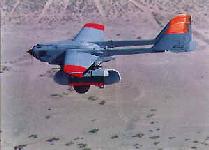FAS |
Military |
DOD 101 |
Systems |
Aircraft |
ROW ||||
Index |
Search |
Join FAS




Phoenix
Phoenix is a real time surveillance and target acquisition Unmanned Air Vehicle (UAV) designed to integrate with the Battlefield Artillery Target Engagement System (BATES) and indirect fire weapon systems against depth targets. The Phoenix UAV is an all weather, day or night, real time surveillance and target acquisition system. Pheonix's surveillance suite is datalinked to a ground station which, in turn, transmits the intelligence gathered directly to artillery command posts. The Phoenix UAV is almost entirely made from Kevlar, glass fibre, carbon reinforced plastics and Nomex honeycomb; and is powered by a 25hp two stroke flat twin engine. The UAV can be launched within an hour of reaching launch site. Up to 2 UAV's can be controlled from the same ground contol station. Phoenix is operated by the Royal Artillery. The contract for Phoenix was placed in 1985 against an In Service Date (ISD) of 1989. This original ISD slipped continuously and, in March 1995, the Equipment Approvals Committee ordered an Agreed Program of Work (APW) to be established and a study into alternative systems. The study concluded that, although there were several UAV systems that came close to matching the requirement, none did so as closely as Phoenix. A major contract amendment was negotiated with GMAeS and, in September 1996, Ministerial approval was secured to return to contract against an ISD of December 1998. At the time of return to contract it was hoped to bring Phoenix into service in mid-1998, but some technical difficulties, together with the need for a comprehensive Safety Statement and a Military Aircraft Release, resulted in exact alignment with the endorsed ISD.Specifications | |
| Country of Origin | UK |
| Builder | |
| Role | |
| Similar Aircraft | |
| Wing Span | 5.5m |
| Length | |
| Height | |
| Weight | 177 kgs |
| Engine | |
| Maximum speed | |
| Cruising speed | |
| Flight Radius | 50 kms |
| Service Ceiling | 2700m (9000 ft) |
| Cost | |
| User Countries | |
| Quantities | eight troops (two batteries each with three flight troops and two flight troops at the Royal School of Artillery) with a total of 198 UAVs and support equipment Ground Data Terminal (GDT) and Ground Control System (DCS), Launchers, Recovery Vehicles, Resupply Vehicles - Troop Command Post (TCP) |
| Total Costs | £259.4 million (estimated) |
| In-Service Date (ISD) | December 1998 |
| Complete Regimental Conversion Training | July 1998 |
| Achieve Maintenance Reserve status | October 1998 |
| Complete Flight Section Refurbishment | February 2000 |
| Complete War Maintenance Reserve Air Vehicle deliveries | January 2001 |
| Transfer to Defence Logistics Organisation | April 2001 |

Sources and Resources
FAS |
Military |
DOD 101 |
Systems |
Aircraft |
ROW ||||
Index |
Search |
Join FAS
http://www.fas.org/man/dod-101/sys/ac/row/.htm
Maintained by Robert Sherman
Originally created by John Pike
Updated Tuesday, September 21, 1999 10:18:15 AM